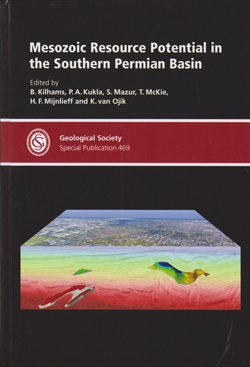
This volume comprises a set of papers concerning the Mesozoic resource potential of the Southern Permian Basin, which is much better known for its Palaeozoic gas reservoirs. After an interesting scene-setting introduction that compares and contrasts hydrocarbon and hydrothermal resource development and points to the latent potential in the Mesozoic, papers are organised into sections starting with the tectonic framework and then stratigraphically. Most papers are concerned with conventional hydrocarbons, although one focusses on the German Posidonia shale as a source of unconventional oil and gas, and another on hydrothermal energy.
The section on tectonics covers uplift, basin inversion, fault reactivation and salt movement. Different inversion events vary in their relief and scale across the basin. The low relief and aerially extensive nature of the Paleocene Laramide event suggests mantle processes were at play, while other localised events are more easily ascribed to crustal shortening. Examples from the Baltic Sea involve deep-seated fault reactivation, while the interplay between tectonics and salt movement are of great importance for sedimentation patterns in the Dutch offshore and elsewhere, and studies suggest relationships between salt-layer thickness and diapir spacing.
The first paper on the Triassic discusses significant over-pressuring in the Dutch offshore resulting from sediment loading on top of salt, as well as fault-related vertical and lateral permeability barriers, while the second paper deals with enhanced recovery of gas using nitrogen as a displacement vehicle in the De Wijk field. A third study concerns the application of data mining to free online data for the Volpreihausen sandstone. Jurassic papers focus on synrift tectonostratigraphy and basin evolution, paleogeography, and potential impact of Quaternary ice loading and unloading on maturation and expulsion respectively.
In the Cretaceous Northern North Sea, the exploration challenge is to find sparsely distributed, deep marine sandstones in parts of the basin where thick overburden, multiples and sub-optimal impedance contrast all hinder seismic identification of such sand bodies. Elsewhere German and Dutch offshore erosional valleys may provide reservoir or sealing potential depending on their fill, while giant pockmarks constrain the timing and potential migration pathways from deeper, Carboniferous, levels. The volume ends with tectonics and the development of uplifted Chalk islands and their erosional products which has implications for further exploration potential in the inverted basins of NW Europe.
Overall the quality and presentation of the work in this publication is to a very high standard. In my view it is a valuable addition and makes for an interesting read.
Reviewed by David Latin
MESOZOIC RESOURCE POTENTIAL IN THE SOUTHERN PERMIAN BASIN by B. Kilhams, P.A. Kukla, S. Mazur, T. Mckie, H.F. Mijnlieff & K. Van Ojik, (eds) 2018. Published by The Geological Society, SP 469, 572 pp. (hbk.) ISBN: 9781786203847.
List price: £ 130.00
Fellow's price: £ 65.00
W: https://www.geolsoc.org.uk/SP469